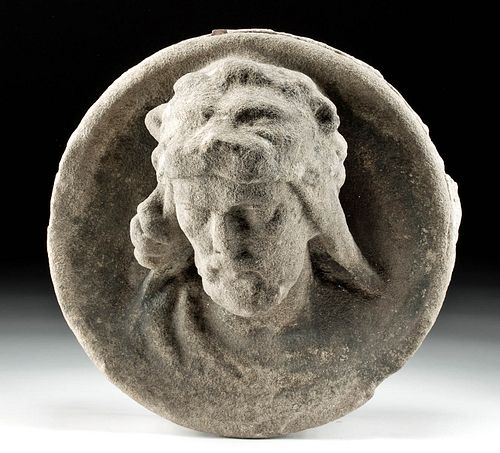Norman British Stone Roundel w/ Lion-Headed Man
Lot 70
About Seller
Artemis Fine Arts
686 S Taylor Ave, Ste 106
Louisville, CO 80027
United States
Selling antiquities, ancient and ethnographic art online since 1993, Artemis Gallery specializes in Classical Antiquities (Egyptian, Greek, Roman, Near Eastern), Asian, Pre-Columbian, African / Tribal / Oceanographic art. Our extensive inventory includes pottery, stone, metal, wood, glass and textil...Read more
Estimate:
$4,500 - $6,750
Absentee vs Live bid
Two ways to bid:
- Leave a max absentee bid and the platform will bid on your behalf up to your maximum bid during the live auction.
- Bid live during the auction and your bids will be submitted real-time to the auctioneer.
Bid Increments
| Price | Bid Increment |
|---|---|
| $0 | $25 |
| $300 | $50 |
| $1,000 | $100 |
| $2,000 | $250 |
| $5,000 | $500 |
| $10,000 | $1,000 |
| $20,000 | $2,500 |
| $50,000 | $5,000 |
| $100,000 | $10,000 |
| $200,000 | $20,000 |
About Auction
By Artemis Fine Arts
Jul 22, 2021
Set Reminder
2021-07-22 10:00:00
2021-07-22 10:00:00
America/New_York
Bidsquare
Bidsquare : Summer Antiquities & Ethnographic Art Auction
https://www.bidsquare.com/auctions/artemis-gallery/summer-antiquities-ethnographic-art-auction-7245
Travel around the world and back in time...and be amazed at the treasures you will find! Antiquities from Egypt, Greece, Italy and the Near East, Asian, Pre-Columbian, African / Tribal / Oceanic, Native American, Spanish Colonial, Russian Icons, Fossils, Fine Art, much more! Artemis Fine Arts info@artemisfinearts.com
Travel around the world and back in time...and be amazed at the treasures you will find! Antiquities from Egypt, Greece, Italy and the Near East, Asian, Pre-Columbian, African / Tribal / Oceanic, Native American, Spanish Colonial, Russian Icons, Fossils, Fine Art, much more! Artemis Fine Arts info@artemisfinearts.com
- Lot Description
Northern Europe, England, Norman culture, ca. 10th to 12th centuries CE. A magnificent hand-carved stone roundel, likely from a church, presenting the bust of a male wearing a lion's head. Remarkably life-like, the intriguing man gazes outwards, extending outside the confines of his stone tondo into the space of the viewer to observe the goings-on of those below him. His ancient visage presents large, sunken eyes, a flat nose, and full lips enveloped by a bushy moustache and beard. A fierce lion's head engulfs him, the top jaw of the beast resting atop his skull, as it displays a thick mane, perky ears, and a broad nose. The ferocious paw of the creature can be seen reaching forwards towards the figure's face on his right side. The expressionless appearance of his stare is characteristic of sculpture found in Medieval churches, as passionate physiognomy was regarded as sinful throughout the Middle Ages. Size: 9.25" W x 13.5" in diameter (23.5 cm x 34.3 cm)
Who could this figure represent? There are many options. In Greco-Roman motifs, the mythological hero Hercules was frequently shown wearing the head of the Nemean lion, who he had slaughtered. Serving as a symbol of strength and courage, rulers, such as Alexander the Great and Commodus, modeled their image after the hero and, thus, were also commonly depicted wearing a lion's head. It would make little sense, however, for the bust of any of these figures to be found in a church. The ferocious animal is also a prominent figure in Christian art via the stories of Daniel, who was saved from a lions' den by an angel, St. Mark the Evangelist, who was rescued from 2 lions by Christ, and Samson the Nazarite, who was said to have slayed a lion with his bare hands. Unfortunately, there is no artistic tradition of any of these figures wearing the head of a lion. It is also possible that it may not be a reference to a specific figure, but instead be intended to symbolize the Christian values of bravery and fortitude. Conversely, if the man is instead being devoured by the lion rather than wearing its head, the example may serve as a warning of the punishment and eternal suffering awaiting one who strays from the righteous path of the church.
While the artistic virtuosity of this sculpture is certainly noteworthy, what is more impressive is its survival capabilities. Art of the Norman era was not only pillaged by Viking conquests, but even further destroyed by the state-sponsored iconoclasm of the Protestant Reformation during the rule of King Edward VI in the 16th century. Indeed, an evocative reminder of the perseverance of art!
Provenance: ex-private United Kingdom collection
All items legal to buy/sell under U.S. Statute covering cultural patrimony Code 2600, CHAPTER 14, and are guaranteed to be as described or your money back.
A Certificate of Authenticity will accompany all winning bids.
PLEASE NOTE: Due to recent increases of shipments being seized by Australian & German customs (even for items with pre-UNESCO provenance), we will no longer ship most antiquities and ancient Chinese art to Australia & Germany. For categories of items that are acceptable to ship to Australia, please contact us directly or work with your local customs brokerage firm.
#163563Losses to nose and peripheries. Expected abrasions, nicks, and softening of detail, commensurate with age. Remains of rope and metal from previous suspension device on verso, as well as some cement from building attachment on periphery. Otherwise, intact and excellent.Condition
- Shipping Info
-
All shipping is handled in-house for your convenience. Your invoice from Artemis Gallery will include shipping calculation instructions. If in doubt, please inquire BEFORE bidding for estimated shipping costs for individual items.
-
- Buyer's Premium



 EUR
EUR CAD
CAD AUD
AUD GBP
GBP MXN
MXN HKD
HKD CNY
CNY MYR
MYR SEK
SEK SGD
SGD CHF
CHF THB
THB












